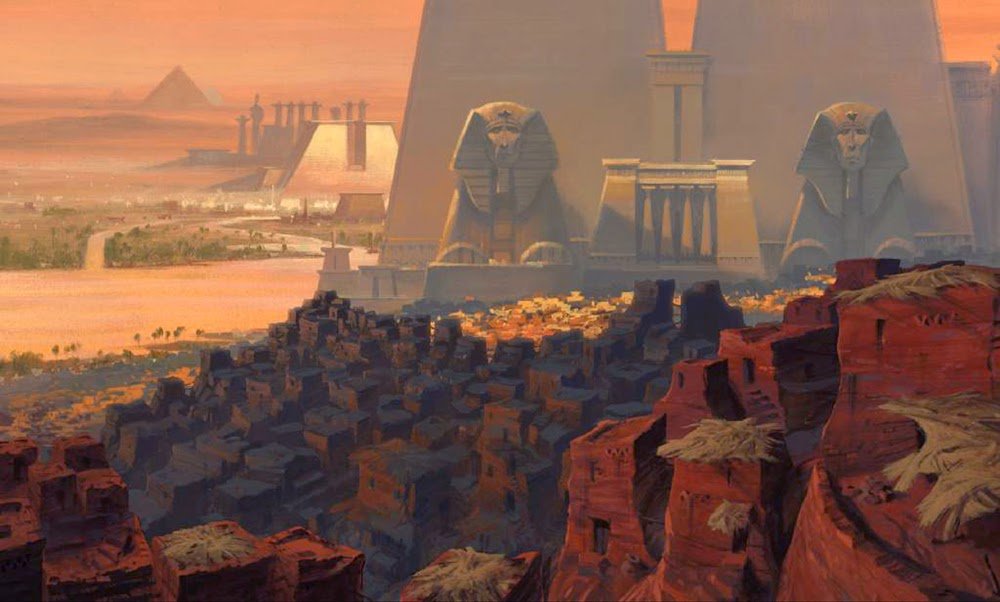In the realm of animated films, few have dared to tread the hallowed grounds of biblical and historical narratives with the ambition and finesse of "The Prince of Egypt." Released in 1998, this cinematic jewel endeavors to recount the epic journey of Moses from a prince of Egypt to a prophet leading his people to freedom. Beyond its surface, the film is a rich tapestry interwoven with themes of faith, identity, and liberation, set against the backdrop of one of history's earliest and most enigmatic civilizations.
A Vision of Ancient Egypt
"The Prince of Egypt" distinguishes itself through its painstakingly detailed portrayal of ancient Egypt. The animation breathes life into the splendors of a civilization renowned for its architectural marvels, from the towering pyramids to the majestic Memphis. These visuals are not mere backdrops; they are integral to the narrative, encapsulating the grandeur and complexity of a society that has fascinated historians and archaeologists alike.
The film's dedication to authenticity extends beyond its architecture, delving into the cultural and spiritual life of ancient Egypt. It presents a society where gods and goddesses are interwoven into the fabric of daily life, influencing everything from governance to the arts. This commitment to portraying the richness of Egyptian civilization provides a vibrant canvas upon which the story of Moses unfolds.
Humanizing Biblical Narratives
At its core, "The Prince of Egypt" is a story of human struggle and transformation. Moses, portrayed with depth and vulnerability, embarks on a journey of self-discovery that challenges his beliefs and identity. This portrayal offers audiences a glimpse into the inner conflicts of a man chosen to lead his people to freedom, humanizing a figure often shrouded in mystique.
The narrative also offers a poignant exploration of the Hebrew people's plight, their enduring hope, and their quest for liberation. By focusing on their resilience in the face of oppression, the film pays homage to the indomitable human spirit. This careful balancing act of historical and emotional authenticity ensures that the characters' experiences resonate with audiences, bridging the gap between ancient texts and contemporary viewers.
Reflecting on Civilizations and Their Legacies
"The Prince of Egypt" transcends its role as an animated film by engaging with broader themes of power, leadership, and the dynamics of civilizations. It prompts reflections on the rise and fall of empires, the legacy of monumental achievements, and the ethical considerations they entail. Through its depiction of Moses' leadership and the eventual exodus, the film explores the complexities surrounding freedom, justice, and human rights.
Moreover, the film serves as a reminder of the timeless nature of these stories and their relevance to modern societal issues. It encourages audiences to reflect on the lessons of history, the consequences of leadership decisions, environmental instabilities, and the ongoing struggles for freedom and equality.
The Bronze Age Collapse, a mysterious period of widespread societal breakdown around 1200 BCE, saw the demise of several advanced civilizations within the Eastern Mediterranean and Near East, including the Hittites and Mycenaeans, arguably impacting the Egyptian New Kingdom's stability. This era of turmoil is characterized by a combination of factors, including, but not limited to, natural disasters, invasions by the Sea Peoples, economic hardships, and internal rebellions.
Such a concatenation of crises might have weakened the once-unassailable Egyptian dominion, making the narrative of Exodus—a tale of plagues, social upheaval, and the mass departure of a subjugated people—resonate as a thematic echo of the larger Bronze Age Collapse. The plagues and subsequent exodus can be seen as symbolic representations of the kind of widespread calamities and population movements that were occurring across the region during this tumultuous period.
Furthermore, the fall of Egyptian rule as depicted in the biblical narrative of Moses and the Exodus could reflect broader themes of change and chaos inherent to the Bronze Age collapse. As Egypt struggled with external invasions and internal disruptions, its grip on power would have naturally weakened, paralleling the struggles faced by Moses and his people in seeking liberation.
This narrative, while deeply rooted in religious tradition, also mirrors historical events where societal collapse leads to a reconfiguration of power dynamics and the emergence of new leaders. Moses’ journey from prince to prophet and leader of the Hebrew people out of Egypt can thus be viewed through a historical lens as emblematic of the larger shifts in power, leadership, and societal structures that were occurring throughout the ancient world during the end of the Bronze Age.
"The Prince of Egypt" stands as a testament to the power of storytelling, capable of bridging centuries and cultures to illuminate the human condition. Its portrayal of ancient Egypt and the biblical narrative of Moses is both a visual and emotional masterpiece, offering insights into the complexities of history and the enduring spirit of hope. As an artistic endeavor, it continues to inspire and resonate, reminding us of the richness of our shared human heritage and the timeless nature of our collective struggles and aspirations.
In the end, "The Prince of Egypt" is more than just a film; it is a portal to the past, a mirror reflecting our present, and a beacon of hope for the future, encapsulating the essence of what it means to be human across the ages.























